Maximalism is an unapologetic grandiose collection of colors, patterns, and art centered around the joys of its creator. Its attitude is ratified in the ‘more is more’ opposition to minimalism.

Maximalism’s formal aesthetic emergence occurred in the late 20th century as a response to minimalism. Its aim and often success pull viewers into a rich, complex, layered, and usually bright experience. Rich color palettes, patterns, repetition, gilded accents, layers, and grandiosity at large scale. It’s important to note the emphasis placed on personal satisfaction and unapologetic self-expression.
The origins of maximalism stretch much farther back than its simple opposition definition. Its nascent beginnings belong to Germany’s Wunderkammer meaning “cabinet of curiosities” or “room of wonder”. These small rooms were filled with collections of exotic specimens and art holding the collector’s interest and were intended to provoke awe and natural conversation among visitors. David Evans notes “..all collecting was marked by curiosity, shading into credulity, and by some sort of universal underlying design.”

On a decisively larger scale, maximalism steps into the 17th and 18th centuries. Europe was Baroque. Extravagant, complex highly decorated interiors. Moving away from natural work specimens and including more art, patterns, and intentional visual density. Baroque’s emergence and encouragement were in response to the austerity of protestant appearances—an interesting reemerging pattern. This age connects with a main thread of maximalism as its highly decorated, often embellished, interiors.
Entrance into the Victorian era came with an increased opulence from only gilded details. Later 19th-century evolution saw the inclusion of colors and patterns in addition to art and objects with priority to items that expressed one’s identity. Emphasis on color most likely came about due to the discovery and continual commercial advancements in synthetic dyes, increasing variety, intensity, and availability. Progressing into the 20th century and inevitable creative limitations from war rationing, facilitated abstract expressionism and eventually minimalism.
Jackson Pollock’s style incorporating bright colors, emotion, energetic explorations, movement, and self-expression positions him as a pioneering precursor to maximalism.
Yayoi Kusama is a Japanese contemporary artist primarily working in sculpture, installation, and painting. Born in 1929 and began her art career in the 1950s. Her trademark orderly and extravagant dot theme plays across both minimalism and maximalism. Infinity mirrored rooms are specifically immersive and excessive, maximalism’s signatures—and available to visit at permanent installations in select international locations.

Italian fashion designer Gianni Versace’s distinct vivid colors, bold prints, and grand embellishments were a refreshing contrast to tastes that primarily used muted colors and simplicity—his specific flavor and expense in design call back to the grandiose virtues of maximalism.

Tony Duquette began holding a wild set of skills designing movie sets, costumes, jewelry and select individuals’ home interiors in Los Angeles beginning in 1935. Throughout a long career and multiple personally curated interiors. His lasting maximalism touch is still alive through Tony Duquette Studios’ interior design firm. As well as a survey of his life in the book More is More: Tony Duquette.


Maximalism is frequently identifiable in interior decoration with notable successes in fashion. Johnson Hartig is a contemporary fashion designer, and current CEO of Libertine, who recently opened his home for view and exemplifies both audaciously. In the words of Kelsey McKinnon, and echoes of definition, “[he] has fashioned… his home around a trove of art and objects amassed over a lifetime of travel and treasure hunting.”

Maximalism is a movement that thrives on excess, abundance, and extravagance. It’s important to note that maximalism isn’t just a collection of stuff. It’s an aesthetic. As such the collection and display of items have a theme, a collective feeling, and a rhythm. Reddit user spaghettiryhmes succinctly points out, “variety of colors and patterns, create the visual effect of having a lot of stuff going on, without necessarily having a lot of objects.” This emphasis on visual effects coupled with specific themes has influenced recent trends and micro trends including maximalist minimalism, cottagecore, academia, grandmillenial, and dopamine decor.

4 Comments. Leave new
I love to see how the birth of one movement creates a counter-movement later and the clash between them. I enjoy the maximalist aesthetic more. There are just a lot of bizarre aspects to it and so much to look at. I enjoyed history with the movement too!
The bizarre aspects and continual curiosity really drew me to the aesthetic. It’s not one I could ever live in but it’s fascinating to view.
Hello Jax,
This is a well-documented post on the definition of maximalism, along with its historical roots, including eras such as the Baroque and Victorian periods. This really shows how the aesthetic has not only changed over time but also how each era incorporates the aesthetic into their lives.
One aspect that I found a bit confusing in your post is the term “maximalist minimalism” mentioned at the end. You also discuss Yayoi Kusama and how her work embodies elements of both maximalism and minimalism. In your post, you stated that maximalism was created to oppose the nature of minimalism. While your focus is on maximalism, could you clarify which features of maximalism are reflected in the term “maximalist minimalism”? Additionally, could you elaborate on the key aspects of Yayoi Kusama’s works that utilize maximalism, considering that her art often blends both aesthetics?
Hi Daniel, Thank you for your feedback. I hope I can provide more clarity here. Maximalist minimalism is a particular combination of both styles appropriate to the space. When combined, minimalism offers a slice of boldness in its limited decor items and clean surfaces. Minimalism limits the excess and overwhelms often seen with maximalism.
Yayoi Kusama is interesting because she uses the same dot theme to span minimalism and maximalism without really ending up in the middle. Her minimalist works usually use precisely placed, large dots or smaller dots with a more monotone background (see Infinity Nets from 2000). In turn, her maximalist works usually dominate her search results; her infinity rooms specifically touch on the grandiose scale and excess visual happenings underlining maximalism aesthetics.